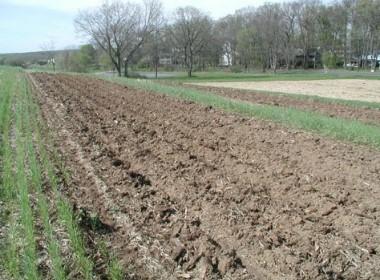By Sjoerd Willem Duiker, Peter Kleinman and David A. Verbree
Highlights from research results from 2007/2008 may help plan for the coming year’s tillage system including effects on runoff, erosion, and phosphorus loss on soils with different drainage characteristics
Surface application of manure in no-till systems is a water quality concern because it can lead to increased concentrations of dissolved phosphorus (P) in runoff. However, incorporating manure with tillage is both a water quality and soil health concern because it can lead to increased soil erosion and particulate P loss. The dynamics might be different for poorly drained and well-drained soils. This was studied in central Pennsylvania, where deep, well-drained soils dominate in the valleys, while poorly drained soils with seasonally high water table due to impervious fragipan can be found on the hillslopes. The fields for this study had been in long-term no-till (> 10 yr) before initiating the experiment. No-till and chisel/disking were used to grown corn in 2007 and 2008, planted on the contour on soils with 7-8% slope. A rye cover crop was seeded at 2 bu/A in fall included as part of the no-till system, but not used with chisel/disking. Dairy manure was broadcast in the spring and not incorporated with no-till, while it was incorporated in chisel/disked plots within days of application. Manure application rates varied from 3500-7000 gal/A depending on application recommendations.

Figure 1. Manure was surface-applied in no-till plots that did have a fall-planted rye cover crop.
Figure 2. Manure was incorporated in chisel/disked plots.
Runoff plots (2x2 m) were soaked with about 1 inch of water the day prior to the rainfall simulations to bring surface soils to similar moisture contents. High intensity rainfall (almost 3”/hr) was applied for one hour in rainfall simulations a few days after planting, mid-season, and post-harvest, and runoff, soil loss, and dissolved and particulate P loss were measured. A 3”/hr storm represents a 50-yr storm for this location. In both years and on both soils, no-till yielded significantly less sediment than did chisel/disking. In fact, soil loss with chisel/disk tillage was 5 times greater than that with no-till on the somewhat poorly drained soil, and 12 times greater on the well-drained soil. Effects of tillage system on runoff and P loss differed between soil types. On the well-drained soil, runoff from no-till was much less than with chisel/disking, but on the somewhat poorly drained soil there was little to no reduction in runoff with no-till. This was expected because typically, on a well-drained soil, the surface protection offered by surface crop residue reduces sealing and crusting and with the improved macroporosity increases infiltration into a soil that has plenty of space to absorb that water. On a poorly drained soil, on the other hand, the profile is often quickly saturated and cannot take in any more water, so despite the reduction of sealing with no-till water will still run off. The differences in infiltration effects between soil types led to total P loads that were 22–50% less with no-till on the well-drained soil, but 40–47% greater with no-till on the somewhat poorly drained soil. On the well-drained soil, particulate P loss was more than dissolved P loss, but on the somewhat poorly drained soil, dissolved P loss from surface applied manure was more important. This study had some shortcomings just like any other study. It may be questioned if high-intensity rainfall of 3”/hr for one hour is a common occurrence, especially in the spring – based on past records it is definitely a ‘worst-case’ scenario. On the other hand, we expect more high-intensity rainfall in the future. Another shortcoming of the study was the small runoff plot size. We observed that, especially during the first rainfall simulation, ridges formed by the planter in chisel-disked plots kept ponded water from reaching the outlet of the runoff plots. It is possible that on a larger field scale this water would break through the ridges if they were not completely on the contour. Nonetheless, the study showed us important differences in effects of tillage systems on runoff and phosphorus losses on soils that vary in drainage characteristics, and important similarities in their effects on soil erosion.
The study confirms the benefit of no-till for erosion control on both poorly and well-drained soils. Further, it showed that runoff and total P loss was reduced with no-till on well-drained soils. On the other hand, it showed increased dissolved P loss in no-till on somewhat poorly drained soils where the absence of manure incorporation can exacerbate dissolved P losses. Instead of using field-wide tillage, manure can also be incorporated with shallow-disk injection to conserve soil-health and reduce erosion potential. Based on this study, manure injection in no-till would be especially important on poorly drained soil to mitigate P losses to surface waters.
Figure 3. Runoff was much reduced with no-till on well-drained Hagerstown soil, but not on somewhat poorly drained Buchanan
Figure 4. Total P loss was reduced in no-till on well-drained Hagerstown, but greater with no-till on somewhat poorly drained Buchanan. Dissolved P-losses from the Buchanan soil were the major reason for higher total P losses on this soil with no-till
Figure 5. Rainfall simulator used in this experiment.